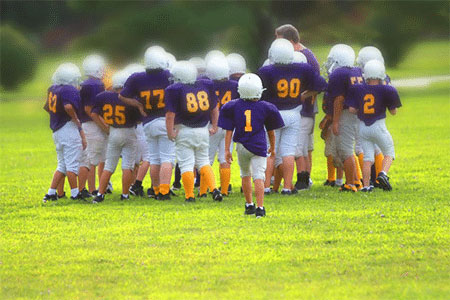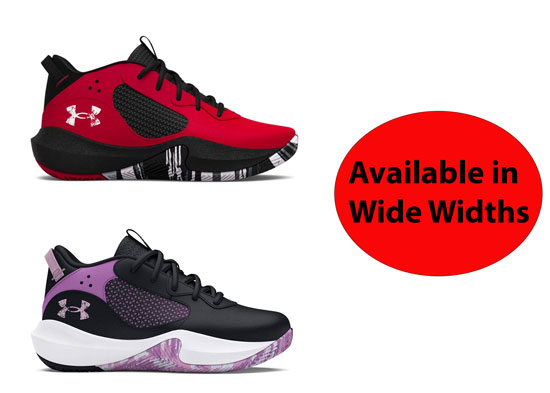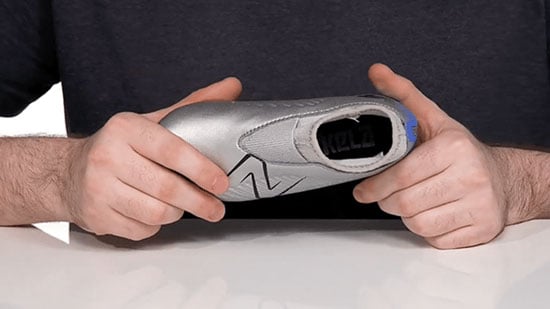Best Football Cleats for Boys – Protect Your Child’s Feet and Prevent Injuries!

Young athletes should wear football cleats that are functional and provide the support and protection they need. However, one of the best ways to keep your young athletes’ feet healthy is to make sure that they wear the cleats in the correct shoe size. I have put together a selection of the best football cleats for boys, and I will show you these cleats shortly. I will also show you how to make sure that you order the cleats in the correct size.
Parents should also know that they don’t need to buy the most expensive cleats to keep their kids’ feet healthy. More expensive cleats don’t automatically translate into better shoes for your child, and you should always keep in mind that your child’s cleats will only last one season.
Pro Tip: If you’re pressed for time, you can go straight to the selection of football cleats for boys.
At What Age Should Children Start Wearing Football Cleats?
There is no set age for children to start wearing football cleats. The coach is the person who will be able to tell you when is the perfect time for your child to start wearing them.
It can be confusing for parents to decide which football cleats to choose from as there are several options out there, but don’t worry, at the end of this article I will show you a selection of the best football cleats for boys.
All Cleats Are Not the Same!
Parents need to understand that not all cleats are the same. I mention this because parents are always asking whether their children can wear their baseball or soccer cleats to football. I strongly suggest that you provide your child with a pair of cleats specifically made for football to maximize performance and avoid injuries.
While soccer cleats are the most versatile type as children can wear them for multiple types of sports such as football, baseball, and lacrosse, they won’t protect your child’s feet effectively against injuries as football cleats.

Are You 100% Sure of Your Child’s Foot Length and Shape?
Determining your child’s proper shoe size is essential to a comfortable fit for football cleats. Do you know whether your child has narrow, medium, wide, or extra wide feet? Do you know if your child has a high instep or not? These are all factors that determine the final shoe size that your child should wear. Since most shoe stores are closed now I came up with a system that helps parents determine their child’s exact foot size from home
The “growth plates” in boys’ bones don’t finish closing until they reach the ages of 15 to 17. When these “growth plates” are stressed during a particular activity or sport, they become more susceptible to injury. The correct type of football cleats will protect your child’s feet and help prevent injuries.
What Types of Cleats Are Best for Youth Football?
Most football games are played on grass or synthetic turf, so I suggest that you buy your child a shoe that can be used on both surfaces. The rubber bottom cleat is the one I recommend as it’s the best in terms of both playing surfaces.

Low, Mid, or High-Top Cleats for Children?
Football cleats come in three different heights to accommodate the varying needs of players by position:
- Low-Cut: Low-cut shoes are more lightweight and allow young players to make quick cuts on the field. I don’t recommend low-cut football cleats because they provide less support and protection against ankle injuries.
- Mid-Cut: Mid-cut shoes offer better support than low-cut ones while still allowing maneuverability. This style is the one I recommend the most as it’s a middle ground option that balances the others. The mid-cut fits the game of players in the following positions: defensive backs, running backs, wide receivers and quarterbacks.
- High-Tops: High-top shoes extend up the ankle to provide extra protection and support, especially for lateral movements to reduce the risk of ankle sprains. Linemen can benefit from wearing high-tops as they spend a lot of their time moving from side to side during a game, which puts a lot of stress and strain on their ankles.
By now you should know your child’s exact foot size and the importance of providing your child with the correct type of football cleats.
The football cleats I recommend won’t make your children better football players, but they will significantly boost their efficiency as they will definitely allow them to play at their best. Disclosure: Some links in this post may be affiliate links and we may receive a small commission (at no extra cost to you) when you click our links and make purchases.
Best Football Cleats for Boys
Take a look at the description below each football cleat to check what type of foot shape is capable of fitting (narrow, medium, wide).
- Shoe style Vapor Edge Shark 2 by Nike
- Available in wide widths
- Padded collar to increase comfort and prevent blisters
- Synthetic leather is long lasting and supportive while keeping your kids’ feet comfortable
- Nike Fastflex technology with rubber studs creates flexibility and traction for bursts of speed, quick cuts and sudden stops
- Lace-Up closure
- Order this shoe a whole larger than your child’s current foot size
- Shoe style Spark 23 by Adidas
- Fits medium and wide feet
- Padded collar to increase comfort and prevent blisters
- Cushioned midsole
- Lace-Up closure
- Order this shoe a whole larger than your child’s current foot size
- Shoe style Freak Spark by Adidas
- Fits medium and wide feet
- Pull tabs at the heel and tongue for easy on-and-off
- Full-length Phylon midsole delivers lightweight cushioning underfoot
- Triple velcro closure
- Order this shoe a whole larger than your child’s current foot size
- Shoe style Leadoff by Under Armour
- Fits medium and wide feet
- Padded collar to increase comfort and prevent blisters
- Lightweight Bounce cushioning provides enhanced comfort and flexibility
- Slip-in shroud upper with adjustable hook-and-loop straps for ultimate lockdown feel
- Order this shoe a whole larger than your child’s current foot size
- Shoe style Spark 23 by Adidas
- Fits medium and wide feet
- Lightweight
- Mid cut for added ankle support
- Lace closure for a secure fit
- Order this shoe a whole larger than your child’s current foot size
- Shoe style Spark Md-Team by Adidas
- Fits medium and wide feet
- Lightweight
- Mid cut for added ankle support
- Lace closure for a secure fit
- Order this shoe a whole larger than your child’s current foot size
Make sure that your child tries the football cleats with the same socks that he will be wearing on the field.
What Shoe Size Should You Order?
Don’t assume your child’s football cleat size is the same as it is with other shoes. To allow for growing room, I highly recommend that parents order this football cleat a whole size larger than their child’s current foot size. This translates to 3/8 of an inch or 0.8 centimeters of space between your child’s longest toe and the end of the cleats.
Comfort is key! Have your child test the shoes and make sure that they feel comfortable. The cleats will soften up with time but they should be comfortable from the first time your child tries them on.
Contact Us – Get a Personalized Recommendation!
You can ask your questions in the comments section below or contact me directly via email:
How to Tie Your Kids’ Sports Shoes?
I suggest that you apply a specific shoe lacing technique that my coworker who has over 20 years of shoe fitting experience taught to me. The shoe lacing technique helps secure your child’s feet inside the shoes and will make your child feel more stable when running.
Here is a different resource in case your child is into playing flag football.
My Child Complains the Cleats Are too Tight – Let’s Find Some Wide Football Cleats
In general, your child’s cleats are supposed to be snug. The cleats shouldn’t be so tight that they feel uncomfortable or cut off the circulation of your child’s feet, but you want them to feel responsive, which means they should be snug.
If you notice that the cleats are making your child’s toes overlap or rub against one another or the side of the shoes then your child might have wide feet and need a different cleat that fits wider. I wrote a different article that describes the best football cleats for children with wide feet.
Before you leave I also wanted to show you a selection of socks that will help prevent foot issues such as blisters.
Football Socks for Kids – Extra Cushion for Your Kids’ Feet!
The football socks I recommend are made of breathable materials, dry-quick, and also provide extra cushion below the toes and the ankle to prevent blisters.
The football socks below provide targeted cushioning on the footbed for shock absorption and it will reduce the friction between the foot and the cleat. Below you can find a selection of the best football socks for children:
Finding a pair of football cleats for kids can be time-consuming. I hope I made things easier for you and now your child can play football comfortably.
Have you found a good football cleat that has worked well for your child’s feet? Let me know in the comments section below and that way other parents can benefit from your experiences.











